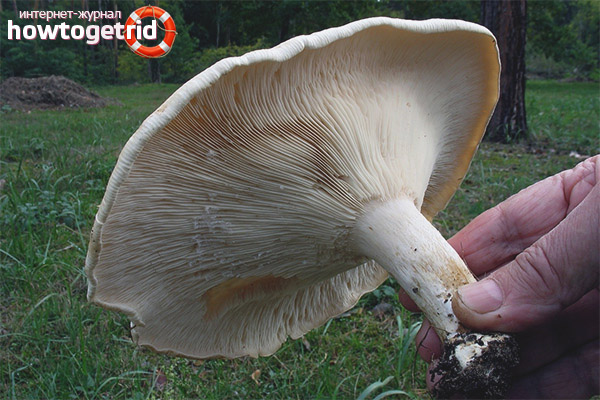The content of the article
The giant talker - the Latin name Leucopaxillus giganteus - belongs to the Ordinary family of the genus Leucopaxillus or White-eyed. Strictly speaking, it belongs to the genus Svinukh, and not to the Talkers. But this is not so important, because both genera are related and are included in the same family. You can also find the name Gigantic Svinukha and Ryadovka giant. This mushroom is edible, but conditionally.
Mushroom description
As the name implies, the mushroom is quite large, its hat reaches a size of 30 cm. Basically, its average size is about 20 cm. The shape is a slightly twisted funnel. The edges of the hat are wavy with blades, and the color is white with an ash-gray tint.
The mushroom is lamellar, and the color of the plates changes from very light to cream. The plates are descending and go close to each other. The pulp is dense, white in color. The giant talker does not have a specific taste, but there is a recognizable powdery aroma. The spores are white.
The leg of the mushroom is almost 4 cm in diameter, and its length varies from 4 to 7 cm. In relation to the hat, it is not high, but thick. In shape it resembles a cylinder, and in color it is light, like the mushroom itself. It does not have a veil on itself and tapers to the base.
It grows in Russia, mainly in its European part, and is also found in the Caucasus. Talkers love open places, in particular glades in the forest. Interestingly, this fungus sometimes draws peculiar circles with the location of its fruiting bodies.
The edibility of a giant talker
It is recommended to use young fruiting bodies in food, because large ones have a bitter aftertaste. However, large talkers can be dried.
Like all mushrooms, among the talkers there are very poisonous species. Therefore, it is extremely important to entrust the collection to a professional and not take the mushroom if in doubt.
Healing properties
It was revealed that the pulp of giant talkers contains clitocybin A and clitocybin B. These are antibiotics that can fight tubercle bacillus. The antibacterial properties of this fungus are not in doubt. Talkers are even used to improve the condition with a disease such as epilepsy.
They began to study this interesting mushroom and as a result revealed many useful properties. As it turned out, sows contain both animal proteins and plant proteins. In addition, they have a high content of various trace elements, their main ones:
- manganese;
- zinc;
- copper;
- vitamins B1 and B2.
Medicines are produced from this fungus. They can be seen under the names clitocybin, diatretin, nebularin.
Like all mushrooms, govorushki contain very few calories and can be part of various diets. They also help cleanse the body of toxins and toxic substances, as well as harmful metals.
Pigs found widespread use in folk medicine. They have established themselves as a remedy for kidney stones and various respiratory infections. Apply them in the form of decoctions, as well as ointments made from mushrooms.
Related species
Snow talkers grow around May. Appear in forests with conifers, in sunny meadows. You can see them in groups, and very rarely alone. The fungus, in principle, is quite rare and is not ubiquitous.
Low-odor talker - this type of talker, which is not suitable for food. In young fruiting bodies, the caps are more convex, and then, as they age, they open into a funnel. The color of the hat is brown or a little beige. The legs are both flattened and cylindrical in shape. Their color is noticeably lighter than the hat. The flesh of the talker is weakly odorous, gray, with a persistent powdery smell and aftertaste. You can meet them in small groups. Appear in December or January. They grow in pine forests, but can also be mixed.











Submit